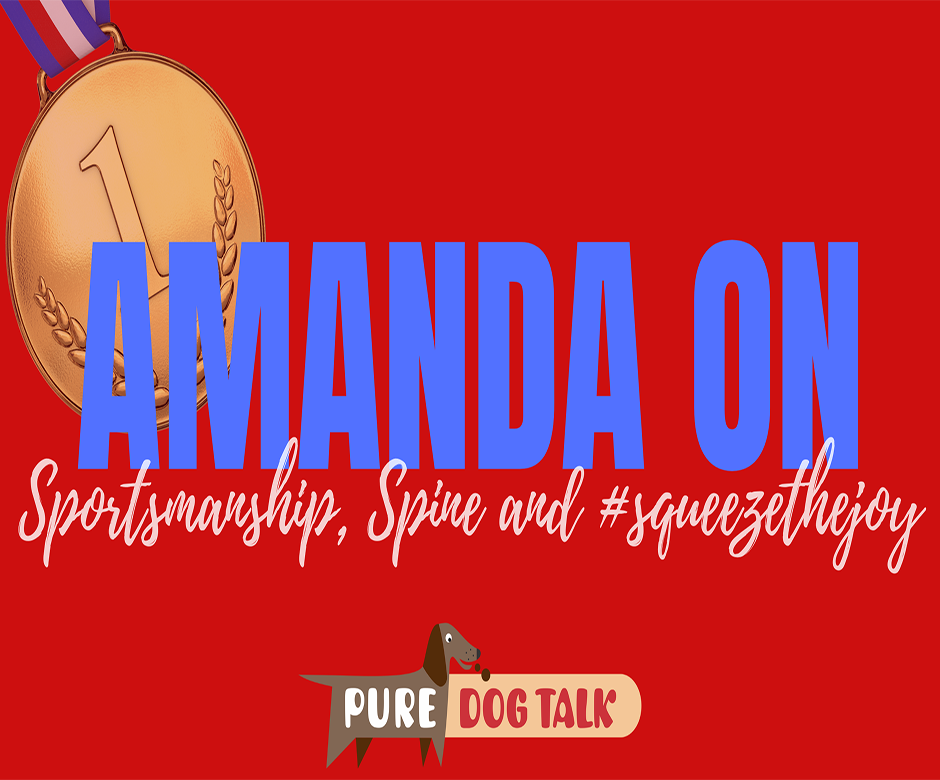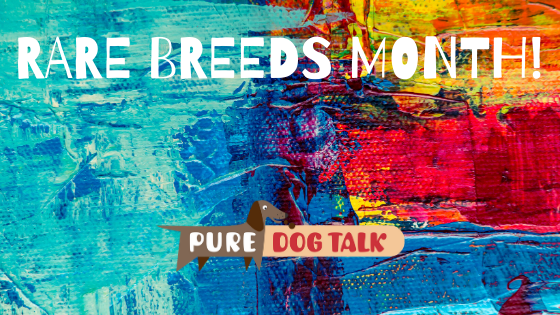528 – Amanda Kelly on Sportsmanship, Spine and #squeezethejoy
Amanda Kelly on Sportsmanship, Spine and #squeezethejoy
Amanda Kelly, Fwaggle Toy Manchester Terriers, joins host Laura Reeves for part two of their wide-ranging conversation discussing subjective sports that was sparked by this year’s Winter Olympics. Today’s topics touch on sportsmanship, “spine,” mentorship and Amanda’s new hashtag, squeeze the joy, about tasting every last drop of joy the sport brings its competitors.
Sportsmanship
“We see the Olympic spirit in many stories every time there’s Olympic Games,” Kelly said. “This year the one that really stood out to me was (a skier) from Finland who won the gold in cross country skiing. (Then) he waited for the last place skier to cross the line before he would celebrate his gold. Because he had respect for the fact that every person in that race, no matter where they finished, had worked really hard to get there. I think that maybe we need a little bit more Olympic spirit in our sport.
Spine = Courage
“This type of subjective sport tends to draw people who are looking outside of themselves for reassurance and validation. Dog shows are an ego sport. We do it on some level for some sort of return in that area of our lives. Thinking about what that is and being able to overcome the challenges that come with whatever reason we’re doing it for. I think that’s a self-awareness piece.
“(That self-awareness gives you) the spine to be able to stand your ground and say ‘it doesn’t matter to me if it’s unpopular. It doesn’t matter to me if all of the cool kids are doing it and I don’t want to. I’m gonna do what I wanna do the way I wanna do it based on my own opinion and my own values.’
Perspective
“I really think that in the dog world we have to be cognizant of context for the importance of our sport and the people in it. There’s a lot of stuff going on in the world right now and there’s a lot of stuff that’s going on in the world right now that is a a lot more important than who wins at the dog show. A little perspective is number one. Number two, do not ever drink your own koolaid. It doesn’t matter who you are in the dog world, your importance, celebrity, “fame” is a tadpole in the mud puddle of life. When Ernesto Lara, or anybody really, goes to the grocery store, people are not queuing up for an autograph.
#squeezethejoy
“Sometimes we lose sight of what we’re doing and why we’re doing it. I took a really great pleasure in watching the last Olympic competition for the amazingly great snowboarder Shaun White. He finished fourth. (He was) an incredible competitor, had an incredible career and when he finished, he said that this time it wasn’t really about winning, it was about squeezing the joy out of it. I thought, ‘wow, what a great way of looking at our sport. Squeezing the joy out of the moments that you’re there means making your trip about more than the ribbon that you leave the ring with.”
Listen today to hear the entire conversation. Listen HERE for the first part of the discussion.
481 – When the Best Laid Plans Go Awry
When the Best Laid Plans Go Awry
Amanda Kelly, Fwaggle Toy Manchester Terriers, joins host Laura Reeves for a conversation about dog breeding when you plan ahead, do your research and then the results don’t match the expectations.
Amanda and Laura swap stories about all of the times a breeding looked great on paper and was a disaster on the ground in one way or another. The takeaway? Breeding dogs will keep you perpetually humble and learning.
Unexpected markings. Dual sired litter rabbit holes. Repeat breeding pros and cons. And permission to fail.
A sense of humor helps keep it all in perspective. Keeping temperament and health as top priorities in a breeding program means that even if the pups in a litter don’t meet your expectations for the show ring, they will still live long, healthy lives as beloved companions.
“What I love about (dog breeding) is that there’s not clear answers,” Amanda noted. “We can ponder the theories and the different ideas and we can try new things if we give herself permission to do it. I hope when breeders have been around for a long time and are helping others that, I hope, is the gift that they’re giving them. Permission to try things, to try something new and different. What’s the worst thing that happens? They had some pets. The pet people are pretty happy about that.
“There’s not a right or wrong way to do this. If I’ve learned anything from doing this for many years and watching different breeders, there are 1000 different ways to do this. None of them are right or wrong, as long as we have the welfare of our dogs at heart. And we will learn something new every time.
“Every breeding that you do has value. You said it earlier, you learn something. You learn about what not to do, you learn about how your line is producing. So when that best in show dog winds up neutered because you made a bad choice in your puppy evaluation, you have to let it go.
“You need to be able to make a decision and live with it in the planning of a breeding and the evaluation of puppies. So allowing yourself to fail without feeling like a failure is the greatest freedom that you will give yourself as a breeder. I think sometimes we just get so wrapped up in the breeding that’s in front of us that we won’t allow ourselves to fail, we won’t allow ourselves to say ‘you know what, there’s nothing in here that I want to keep and so I’m going to let them go (to pet homes).”
399 – Breeders Part 2: Family, Friends and Mapping a Journey
Breeders Part 2: Family, Friends and Mapping a Journey
Top Breeders discuss building a family of dogs with small numbers and defined goals.
Wendy Paquette, Amanda Kelly and Chris Heartz return to finish their conversation about building a family of dogs, using the standard as a driver and mapping out a plan.
Wendy: “What I’ve done over the years is lease males from other breeders. I finished (the dogs) for them in Canada and kept them for about six months to a year. I bred 6-10 bitches to that same dog. So, what I did was, I could tell whether there was consistency or not. And I would keep one or two out of every litter and send the dog back home and go from there with the offspring.
“So then, I had a basis with one dog being dominant and if I felt that dominant dog was a great producer consistently, then I doubled on it. But if it wasn’t, oh well, I had bunch of pets that year.
“The Breeders that just breed to the dog next door or the dog in the next state or whatever don’t have a clue what they’re producing. They just keep the most pretty marked puppy that has an attitude then they wonder why they’re not getting anywhere. Well they don’t have any idea where those dogs came from to begin with. They have no foresight.
Health and welfare
Chris: “The health of the breed is everything if you want it to continue. We’re not preservation breeders if we say it doesn’t matter about the teeth (for example), they’re not mentioned in our standard. Well maybe it does matter. And so I think, just by seeing what is available in the rest of the world and how other breeders approach your breed and what they got to show for that is the best education in the world. And to just sit at home and say this is how we’ve always done it. It’s not good enough.”
All in the family
Amanda: “I loved Wendy’s discussion about building a breeding program and having the ability to try different things and having maybe a critical mass of dogs. One of the things I think a lot of people in today’s breeding world struggle with is not having the ability to have that many dogs. For whatever reasons they live in the suburbs or they just can’t keep that many dogs or whatever. Chris gave me some really helpful advice and she talked about working with other breeders in a family.
Chris: “What we really, really are passionate about is, if we can’t sell you a dog and we love this person because they have the same passion and the same commitment to the same type of dog that we have … these are people that dedicated their lives to breeding better dogs … we say we can’t sell you a dog but we can lease you a dog. So our males have way more miles on them than I do.
“All we can give as our gift is our dogs. (We) will share them … with like-minded people and the reason is selfish. Because those people will use that dog and those puppies will have puppies. (I)n the third generation we will see something we love. We then ask them to do the same thing for us and we borrow that dog back and we incorporate … into our breeding program and they just click.”
Developing a plan
Amanda: “It’s about having access to a larger gene pool and it’s about having access to a larger number of dogs. I think for newer breeders (it’s) about developing an eye. You know if you are in a breed where there’s lower numbers, or whatever the case may be, developing your eye can sometimes be a difficult thing. You just see the ones that are yours and maybe go (to) the national once a year, look at pictures on Facebook. But that’s not the same thing as looking at puppies and evaluating and sharing information about what worked and what didn’t work and the trial and error pieces of it that Wendy talked about. When you have great friends, you can share in their journey as well as in yours. And learn as much from what they’ve done and what’s worked for them.
Chris: “You can’t drive to Halifax unless you have a map if you’ve not been there before. It’s no different in breeding dogs. All you need is a plan. If all you see before you is what exists how can you go any further or breed any better.”
Wendy: “We all interpret the standard differently. I think what gets lost in the shuffle is breeders not recognizing quality in other people’s dogs. And that has to be a priority. We all take our own dogs home at night and we all love our dogs. We all have a plan. Whether or not it’s their plan is their problem not mine.”
389 – Working Together Leverages Resources in Rare Breeds
Work Together to Leverage Resources in Rare Breeds
Dawne Deeley and Amanda Kelly are back for the second half of our conversation about rare breeds and their unique challenges.
Who buys our dogs and why?
“It behooves us to think about the drivers for ownership,” Kelly said. “What is it that our breed offers that no other breed offers? What are the challenges that are unique to our breed? What are the barriers for people to consider getting one? Are they not getting any of these rare breeds because they’ve never heard of them? Or are they not getting them because there’s something about them that is maybe not with the average home is looking for? I think that in itself is a really important thing that we all need to understand and think about.
Set up for success
“We can breed the most beautiful dog in the history of the world but 99.9% of anything that we breed is going to go to a pet home… So what are we doing in order to ensure that we’re setting our dogs up for success … setting individual dogs up for success in the homes that they go to has an exponential effect in having people that meet them be more interested in every dog we breed. (They are) ambassadors for our breed.
“My background is in marketing and communication. So I tend to think about things kind of from the perspective of pushes and pulls. We push out information, but we also need to have a pull … we need to have people who are just interested in (the breed) and we need to figure out how we get the breeds in front of them and how we match up our breed with the right home.
We’re all in the same boat
“These breeds that are lower number, they’re the canary in the coal mine. A lot of the more popular breeds … registrations in general are falling. It’s something that the entire dog fancy is facing together. There’s power in numbers and we all have an opportunity to work together, pooling resources, small breeds coming together to do big projects. There’s lots of opportunities to do things, but we have to first recognize that we’re all kind of in the same boat.
“One of the examples that I can give you, a thing as simple as a pedigree database. Something that people can go online and look up pedigrees and do coefficient of inbreeding calculations or different tools that we might offer … breeders in other breeds may not think of that as such a big thing, but it’s just proving to be beyond our reach.
“If there’s opportunities that we can work with other clubs to do things, even something as simple as having access to a teleconference line to have meetings for your club. Our national breed club has struggled with technology, with a lot of older members who can’t figure out how to use Skype or FaceTime … until last year we were having our national breed club meetings in a chat room and typing back and forth to one another … so there are opportunities to help, to support one another, to come together across breeds, to make things happen that will lift us all up, that I think that we need to think about.”




